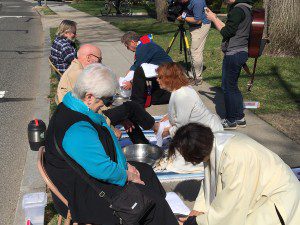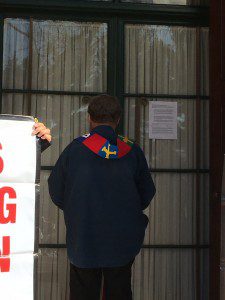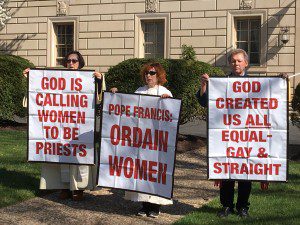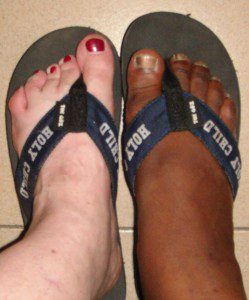
Holy Thursday Breaking News:
Priests Occupy Steps of U.S. Vatican Embassy
Two Roman Catholic Women Priests–Jane Via and Janice Sevre-Duszynska, and former Maryknoll Priest Roy Bourgeois, symbolically washed feet, fasted, and occupied the steps of the Vatican Embassy on Holy Thursday as a visible presence inviting dialogue with Pope Francis on Vatican policy regarding women priests.
On Holy Thursday, March 24th at 10 a.m., people from around the country gathered for a foot washing ceremony and protest in front of the Vatican Embassy in Washington, D.C.
After the ceremony, three Roman Catholic priests delivered a statement to the Papal Nuncio for Pope Francis calling for women’s ordination and justice for women and gays in the Roman Catholic Church. They intend to fast and occupy the steps of the Vatican Embassy in Washington, DC. until they receive a response from Pope Francis. The Papal Nuncio, Archbishop Carlo Maria Viganò, serves as the Vatican’s ambassador to the President of the United States and the gateway between the Catholic hierarchy in the United States and the Pope.

Stole and Statement posted on the Embassy Door
The priests hung a red stole and posted a statement to Pope Francis on the Vatican Embassy door. The statement reads:
TO POPE FRANCIS AND THE CATHOLIC CHURCH:
“Where there is injustice, silence is complicity. We have come to the Vatican Embassy in Washington, D.C., to speak out against the grave injustice being done to women and gay people by the Catholic Church.
1. WOMEN IN THE CHURCH: God created women and men equal: ‘There is neither male nor female. In Christ you are one.’ (Galatians 3:28) God calls both men and women to the priesthood, but Catholic women who are called are rejected because of their gender. Who are men to say that their call from God is authentic, but God’s call to women is not?
The ordination of women is not a problem with God, but with an all-male clerical culture that views women as inferior to men. The problem is sexism and sexism, like racism, is a sin.
2. GAYS IN THE CHURCH: The official teaching of the Catholic Church states that homosexuals are ‘objectively disordered.’ For millions of gay people, this teaching instills shame and self-hatred. It has contributed to gay people being rejected by their families, fired from their jobs, bullied and even killed. This teaching has also contributed to suicides, especially among teenagers.
God does not make mistakes in creation. Our all-loving God created everyone of equal worth and dignity: gay and straight. Our Church’s teaching on homosexuality is cruel and is based on a theology inconsistent with the teaching of Jesus.
We are here today to call upon Pope Francis and the Catholic Church to ordain women and start treating LGBT people as equals.”

Who Are these Priests?
Jane Via, Ph.D., J.D. is a former professor of theology, a retired county prosecutor and an ordained Roman Catholic Woman Priest. In 2005, she founded an independent Catholic parish in the Roman Catholic tradition which thrives in San Diego, CA. She is married and has two adult, feminist sons.
Janice Sevre-Duszynska, D.Min., a retired teacher and journalist, is an activist priest in the Association of Roman Catholic Women Priests and an international leader for women’s equality in the Roman Catholic Church. Her journey is explored in the award-winning documentary, “Pink Smoke Over the Vatican.”
Roy Bourgeois served as a Catholic priest for 40 years. He is a Purple Heart recipient and a Nobel Peace Prize nominee. In 2012, he was expelled from the priesthood and the Maryknoll Fathers because of his public support for the ordination of women.
Why Wash Feet?

Imagine that trudging in sandals along dusty, dirt-covered roads is your primary way to move from one place to another. After walking for hours, you reach your destination and are warmly welcomed. Before you sit down to eat, you are offered the chance to wash up. The root of the practice of foot washing lies in desert hospitality. Historically, the host provided water and a servant to wash the feet of their guests.
During the past thirteen years, my personal experience of dusty feet grew out of twelve incredible weeks wearing sandals in Benin, Ghana, and Nigeria. I am always grateful when water is available to wash my feet. I have never been in a situation where a servant washes my feet.
Washing of the Feet is a religious rite observed by several Christian denominations. References to foot washing can be found in the Hebrew Scriptures (Genesis, Judges, Samuel, Song of Solomon, Psalms) and in the Christian Scriptures. 1 Samuel 25:41 is the first passage where an honored person offers to wash feet as a sign of humility, affirming reform, change and the voiceless. In John 13:13-17, Jesus encourages us to follow his example.
“If I – your Teacher – have washed your feet, you should wash each other’s feet. I have given you an example, that you should do as I have done to you. The truth of the matter is, no subordinate is greater than the superior; no messenger outranks the sender. Once you know all these things, you’ll be blessed if you put them into practice.” (The Inclusive Bible)
The practice of washing feet is found in Eastern Orthodox, Byzantine Catholic, Coptic Orthodox and Syrian Orthodox Churches. Numerous Protestant groups including Seventh-day Adventists, Pentecostal and Pietistic groups, some Anabaptists and several types of Southern Baptists, Anglican, Lutheran, Methodist and Brethren wash feet. In Progressive Judaism, the ritual ‘Brit rechitzah’ involves washing of the baby’s feet.
In many Roman Catholic Churches, historically, only men’s feet were washed on Holy Thursday. For decades, I have chosen to celebrate Holy Thursday in churches where both women and men participate in the foot washing ritual, oftentimes where anyone in the assembly could exercise the option to have their feet washed. In 2015, Pope Francis officially changed the rubrics of the Roman Missal (prayers and texts used in Catholic worship) to open the foot washing rite to women and girls. This change of law didn’t have a significant effect on me. Yet, in many Catholic Churches where only men’s feet were washed, this Holy Thursday it was breaking news: Women as well as men were invited to the altar to have their feet washed!
One of my most memorable Holy Thursdays occurred about ten years ago. I transported six Nigerian and Ghanaian Sisters to Holy Thursday liturgy at a parish in Philadelphia, Pennsylvania. So moved were they by having their feet washed and then washing the feet of the person behind them that they took pictures. Why not? It was a unique, powerful, and priceless experience for these women who had never seen anyone other than a priest or bishop wash men’s feet on Holy Thursday. I will never forget the animated questions their participation in the ritual generated and the lyrical enthusiasm that emanated from the car as we drove home.
What a beautiful way to demonstrate our loving service to each other!
Why Ordain Women?
“I had an education and experience equal to many priests, as well as a deep desire to serve the church, but my female body, according to official church teaching, made my longing to be a priest illegitimate.” ~Jamie Manson
Jamie Manson, in the article, “God Calls My Name, but the Church Won’t Let Me Answer” published on Zocalo Public Square explains,
“The argument really is that basic. The church teaches that women cannot be priests because they cannot “image Christ.” That is, Jesus had a male body and women’s bodies are not a reflection of the male body. It’s a cosmic catch-22: The body God gave women makes God incapable of working through women.”
We heard the Pontifical Biblical Commission when they studied the issue of women’s ordination and, in 1976, concluded “there was no biblical impediment to the priestly ordination of women.”
We heard Pope Francis when he said, “The church has spoken and said no.”
We heard Pope Francis when he said, “That door is closed.” Jamie explains this stance is grounded in the “Theology of the Body.”
“Theology of the Body,” is a teaching first developed by Pope John Paul II in 1979. The late pope argued that though women and men are equal in worth and dignity, their physical and anatomical differences are evidence that God intends them to have different roles and purposes. God designed men and women to complement each other, and their genders dictate their distinct purposes in both church and society.
In 1994, John Paul II declared, as close to the point of infallibility as doctrinally possible, that women would forever be banned from the Roman Catholic priesthood, and that “this judgment is to be definitively held by all the Church’s faithful.”
Really? It’s 2016! Isn’t it time to talk about the ordination of women? Wonder if anyone in Rome or at the United States Conference of Catholic Bishop’s (USCCB) realizes the institutional response “We don’t talk about it” has long passed its expiration date.
From where I stand, in my primary roles as partner of Stan; parent of Ann; child of Arlene and Jim; sister of Mary Clare, Ann, Jim, Brigid, and Brendan; coach, learner, and ordained priest, I have not found holding my hands over my ears and loudly restating a thirty-seven years ago policy an effective posture for meaningful dialogue. I resonate deeply with Jamie’s perspective and I believe many other women do too:
“For me, and I’m sure for other women, there is also a theological reality to why I call myself Catholic. The Catholic tradition teaches that the finite is capable of the infinite and that grace perfects nature. It’s an academic and churchy way of saying that God is present in all of the experiences, people, and objects we encounter in creation. Since the sacred can be discovered anywhere, we are called to be “co-creators”—visible signs of God’s presence in all of our actions and relationships. I love these beliefs. They help me make meaning of my life every day.”
International Movements?
Apparently, the United States isn’t the only place ordained women priests are surfacing. Worldwide membership in Roman Catholic Women Priests (RCWP) and the Association of Roman Catholic Women Priests (ARCWP) numbers 221 and continues to grow. The roots of the movement date from 2002 when seven women were ordained by male bishops on the Danube River. Many now pastor intentional grassroots communities where inclusive rather than gender-specific language is used, all are welcome, and everyone has a voice. Our mission is to support women and men called by the Spirit and their communities to a renewed ministry of service rooted in justice and faithfulness to the Gospel.
The movement continues to grow through membership organizations including Women’s Ordination Worldwide (WOW) and the Women’s Ordination Conference (WOC) as well as communities that celebrate without an officially ordained minister.
In a recent Op-Ed published in the Irish Times, “Rite & Reason: If Jesus Can Wash his Followers Feet Women Can Lead the Church,” Soline Humbert, observes:
“When Jesus washed his disciples’ feet he took on not just a servant’s role but a female servant’s role, for it was mostly women and girls who performed this task: servants for their masters and important guests, wives for their husbands.” ~Soline Humbert
Soline offers insights on Jesus, gender, and how radical an action feet choosing to wash his friends’ feet really was:
“When Jesus washed His followers’ feet He subverted not just the master/servant power relationship but also the male/female relationship. Jesus made Himself a servant girl, a female slave, a wife. He transgressed the strict rules delineating gender roles.”
Soline goes on to quote Mairéad Corrigan Maguire, Nobel peace prize winner from Belfast, who opened WOW’s first international conference in Dublin in 2001. Fifteen years later, the dehumanizing, spiritual abuse continues.
“I believe this kind of attempt to control by the Vatican is an abuse of power. It is dehumanising, demoralising, and is a form of spiritual abuse.”
At the end of the day, each of us is free to choose how we serve. I agree with Sr. Anne E. Patrick, SNJM, in Conscience and Calling: Ethical Reflections on Catholic Women’s Church Vocations:
“It is fitting for Women Transforming Church to give thanks, indeed to preside at Eucharist, and to do this in the name and memory of Jesus, whose ethical ideals, as His followers insisted from the beginning, included the belief that, if it came to a choice, one should obey God and not human beings (Acts 5:27-29).”
In Loving Service
News flash! Jane, Janice, and Roy have met twice with Archbishop Carlo Maria Viganò, who has respected their non-violent protest. Twice police asked if the Archbishop wanted Jane, Janice and Roy to be arrested. The Archbishop did not call for their arrest.
Jesus’ life offers us a model of how to deal with the loss, the rejection, and the injustice that weighs us down, crushes our spirits, and challenges our faith. We don’t need permission to follow the leader.













